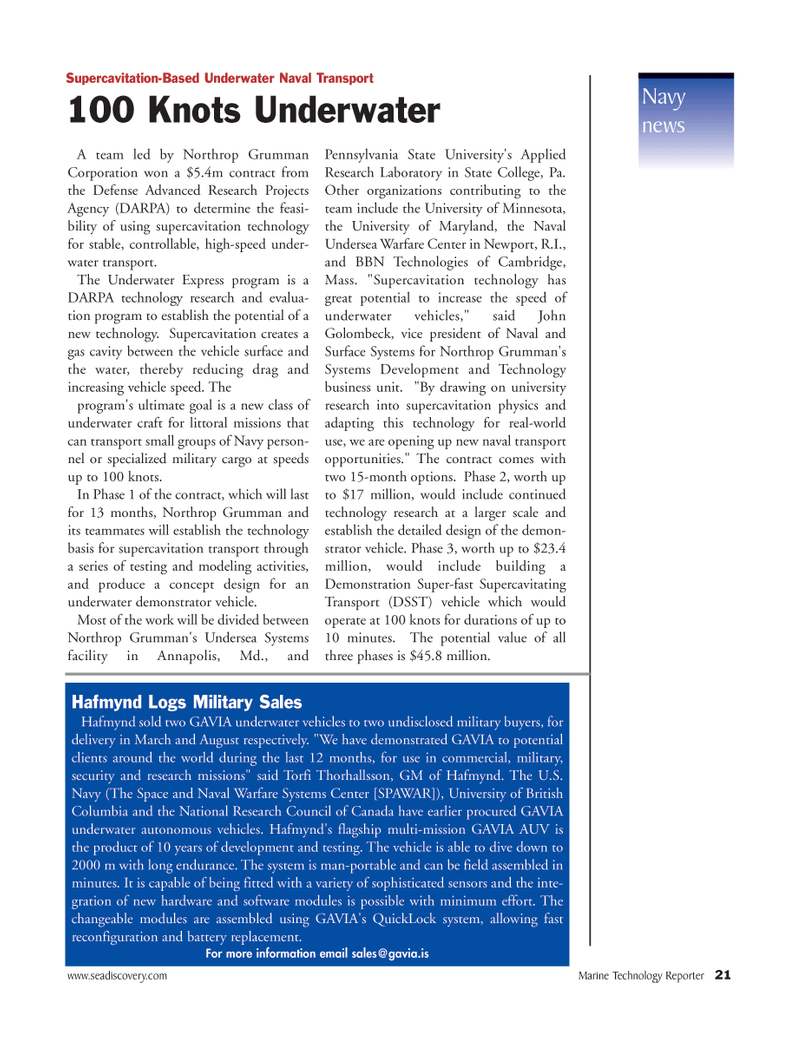
Page 21: of Marine Technology Magazine (January 2007)
Seafloor Engineering
Read this page in Pdf, Flash or Html5 edition of January 2007 Marine Technology Magazine
www.seadiscovery.com Marine Technology Reporter 21
A team led by Northrop Grumman
Corporation won a $5.4m contract from the Defense Advanced Research Projects
Agency (DARPA) to determine the feasi- bility of using supercavitation technology for stable, controllable, high-speed under- water transport.
The Underwater Express program is a
DARPA technology research and evalua- tion program to establish the potential of a new technology. Supercavitation creates a gas cavity between the vehicle surface and the water, thereby reducing drag and increasing vehicle speed. The program's ultimate goal is a new class of underwater craft for littoral missions that can transport small groups of Navy person- nel or specialized military cargo at speeds up to 100 knots.
In Phase 1 of the contract, which will last for 13 months, Northrop Grumman and its teammates will establish the technology basis for supercavitation transport through a series of testing and modeling activities, and produce a concept design for an underwater demonstrator vehicle.
Most of the work will be divided between
Northrop Grumman's Undersea Systems facility in Annapolis, Md., and
Pennsylvania State University's Applied
Research Laboratory in State College, Pa.
Other organizations contributing to the team include the University of Minnesota, the University of Maryland, the Naval
Undersea Warfare Center in Newport, R.I., and BBN Technologies of Cambridge,
Mass. "Supercavitation technology has great potential to increase the speed of underwater vehicles," said John
Golombeck, vice president of Naval and
Surface Systems for Northrop Grumman's
Systems Development and Technology business unit. "By drawing on university research into supercavitation physics and adapting this technology for real-world use, we are opening up new naval transport opportunities." The contract comes with two 15-month options. Phase 2, worth up to $17 million, would include continued technology research at a larger scale and establish the detailed design of the demon- strator vehicle. Phase 3, worth up to $23.4 million, would include building a
Demonstration Super-fast Supercavitating
Transport (DSST) vehicle which would operate at 100 knots for durations of up to 10 minutes. The potential value of all three phases is $45.8 million.
Navy news
Supercavitation-Based Underwater Naval Transport 100 Knots Underwater
Hafmynd Logs Military Sales
Hafmynd sold two GAVIA underwater vehicles to two undisclosed military buyers, for delivery in March and August respectively. "We have demonstrated GAVIA to potential clients around the world during the last 12 months, for use in commercial, military, security and research missions" said Torfi Thorhallsson, GM of Hafmynd. The U.S.
Navy (The Space and Naval Warfare Systems Center [SPAWAR]), University of British
Columbia and the National Research Council of Canada have earlier procured GAVIA underwater autonomous vehicles. Hafmynd's flagship multi-mission GAVIA AUV is the product of 10 years of development and testing. The vehicle is able to dive down to 2000 m with long endurance. The system is man-portable and can be field assembled in minutes. It is capable of being fitted with a variety of sophisticated sensors and the inte- gration of new hardware and software modules is possible with minimum effort. The changeable modules are assembled using GAVIA's QuickLock system, allowing fast reconfiguration and battery replacement.
For more information email [email protected]
MTR#1 (17-32).qxd 1/11/2007 3:54 PM Page 21

 20
20

 22
22
